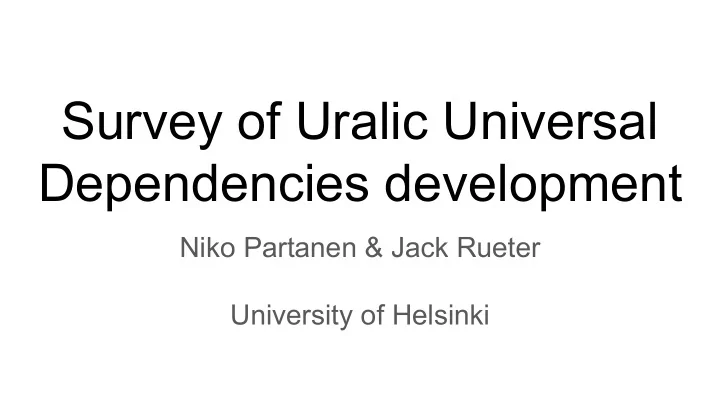

Survey of Uralic Universal Dependencies development Niko Partanen & Jack Rueter University of Helsinki
Uralic languages - A large language family in Northern Eurasia - Approximately 38 languages - Regular morpho-semantic complexity - Relatively free constituent ordering - Both closely and distantly related languages
Uralic treebanks – current status - 11 treebanks in 7 Uralic languages - Missing major branches: Mari, Ob-Ugric and Samoyedic - Geographically Siberia still a missing area - Largest languages best represented
Uralic treebanks – assumptions - As all treebanks are annotated with the same system, it would be reasonable to expect that especially closely related languages are annotated similarly - Some differences are to be expected – these are still different languages - Differences possible at all levels: - Lemmatization - Morphological tags - Dependencies used
Consistency?? - Maximal comparability between treebanks would be desirable - Since the languages are related and not entirely dissimilar, having consistent annotations should be easier to achieve than between unrelated languages - There will be new Uralic treebanks , a common ground on annotations would make initiating this work easier
Example: Personal pronouns Lemma
Treebank Wordform Lemma Lemma msd Estonian: EWT meie mina Pron.Pers.Sg1.Nom Estonian: EDT meie mina Pron.Pers.Sg1.Nom North Saami: Giella midjiide mun Pron.Pers.Sg1.Nom Finnish: TDT meillä minä Pron.Pers.Sg1.Nom Finnish: PUD meillä minä Pron.Pers.Sg1.Nom Finnish: FTB meillä me Pron.Pers. Pl1 .Nom Erzya: JR минек мон Pron.Pers. Pl1 .Nom Karelian hyö hyö Pron.Pers. Pl3 .Nom Komi: IKDP миян ми Pron.Pers. Pl1 .Nom Komi: Lattice миян ми Pron.Pers. Pl1 .Nom Hungarian: Szeged nekünk mi Pron.Pers. Pl1 .Nom
NumeralIssues=Yes NumForm=Letter vs Digit (attested in the Estonian treebanks but nowhere else) Universal Quantifier ‘both’ = ‘all two’ PronType=Tot|PronType=Ind est_ mõlemas mõlema DET Case=Ine|Number=Sing|PronType=Tot hun_ mindkét mindkét DET Definite=Def|PronType=Ind krl_ molompih molompi PRON Case=Ill|Number=Plur Talbanken: bägge bägge DET Definite=Def|Number=Plur|PronType=Tot SynTagRus: обоим оба NUM Case=Dat|Gender=Masc
Copula - North Sámi, Estonian, Hungarian, Finnish and Karelian all have free copulas - Used differently, but regularly - In Erzya copula can fuse into the stem with no clear boundary
Third person singular may be seen as a ZERO formative Personal pronoun tends to precede noun it is equated with Locus of copula marking correlates to constituent stress. (might be seen as contrastive stress)
Participles and features - Deverbal nouns can be treated as nouns or verbs - This decision has high impact to their dependencies too - We compared parallel sentences previously discussed by Pirinen & Tyers (2016)
Example ‘I see the running man’ Language Sentence Features North Saami Oainnán viehkki dievddu. Tense=Pres|VerbForm=Part Erzya Неян чийниця цёранть. Case=Nom|Definite=Ind|Number=Sing Tense=Pres|VerbForm=Part Finnish Näen juoksevan miehen. Case=Gen|Number=Sing|PartForm=Pres VerbForm=Part|Voice=Act Estonian Näen jooksvat meest. Case=Par|Degree=Pos|Number=Sing Tense=Pres|VerbForm=Part|Voice=Act Hungarian Látom a futó embert. ‘ADJ’ _ Komi-Zyrian Аддза котралысь мортöс. PartForm=Pres|VerbForm=Part|Voice=Act
Example ‘I see the running man’ Language Sentence Agreed features? North Saami Oainnán viehkki dievddu. Tense=Pres|VerbForm=Part Erzya Неян чийниця цёранть. Tense=Pres|VerbForm=Part Finnish Näen juoksevan miehen. Tense=Pres|VerbForm=Part Estonian Näen jooksvat meest. Tense=Pres|VerbForm=Part Hungarian Látom a futó embert. ‘ADJ’ _ Komi-Zyrian Аддза котралысь мортöс. Tense=Pres|VerbForm=Part Is there agreement up to this point? Can we document this agreement explicitly?
Other phenomena discussed in the paper - Case names in different languages - Use of indirect objects and obliques - Use of feature Aspect in individual treebanks - Number marking - Marking of evidentiality
Conclusions - Grammatical features specific to Uralic languages largely covered already - Many language specific solutions originate from: - Traditional descriptions - Existing NLP tools (tagsets and conventions used) - Even if everything were carefully checked against other treebanks, differences between them would make the task unclear - With smaller treebanks harmonization-tasks still easily manageable - One way or another, solution probably lies in documentation
Merci! Aitäh! Kiitos! Аттьӧ! Köszönöm! Giitu! Тау! Сюкпря! Thank you!
Recommend
More recommend